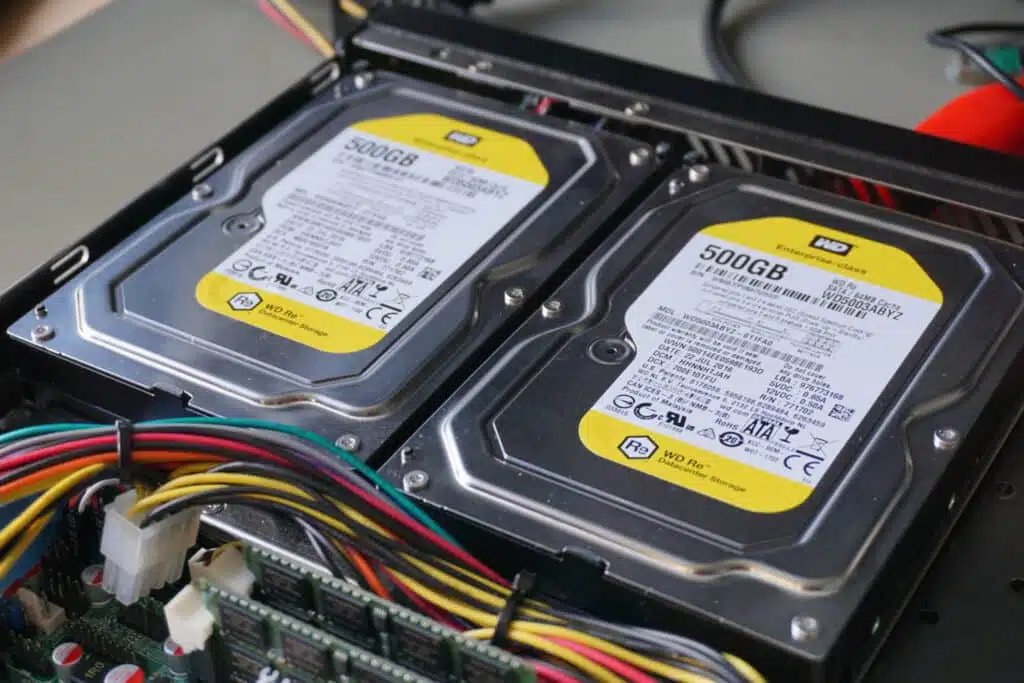02.11.2016

The abbreviation RAID stands for "Redundant Array of Independent Disks", which means "redundant arrangement of independent hard disks". In a technical context, redundancy means that additional functionally identical or comparable parts of a system are present that are not required in normal operation. If a failure occurs, they can step in or, if they are already running in parallel, do the work on their own from then on.
A RAID is a network of at least two mass storage devices(hard disks or SSDs) that work together. The size and type of storage medium should be identical. The different RAID levels (e.g. RAID 0 or RAID 1) differ in the size of the storage capacity and the security of the stored data.
The RAID can be created in different ways. Hardware RAID requires an extra microprocessor, a so-called RAID controller. The chip is often located near the memory and organizes the data distribution. The main processor is not loaded. In larger network environments, such as data centers, external RAID systems are often used.
A software RAID is completely organized on the software side. The RAID can already be implemented in the BIOS in order to subsequently install the operating system on it. So this is secured. Alternatively, the RAID array can also be set up in the operating system first, but then the operating system does not benefit from the RAID. As there is no special RAID controller, all calculations are carried out on the main processor, which, depending on the application, is subject to a higher load.
With RAID 0, two or more storage media are combined to form a logical drive. These can work at an increased speed. For this purpose, the hard disks are divided into blocks of the same size, which are then arranged alternately, as in the zipper method. This technique, which allows all disks to be accessed in parallel, is known as "striping". The advantage of RAID 0 is the acceleration of data transfer. One disadvantage is the lack of security: if a disk fails, data can no longer be fully restored. It is therefore only recommended if reliability is not an issue. As there is no redundancy in RAID 0, strictly speaking it is not a RAID, but only an "array of independent disks".
RAID 1 ensures a high level of reliability with mirroring technology. The data is written simultaneously to all the hard disks involved (usually two). Thanks to two identical disks, there is now full redundancy. In plain language, this means that if one of the two components fails, the remaining hard disk can continue to deliver all data. However, a RAID 1 is no substitute for a data backup. Errors, such as viruses or accidental deletion of files, are immediately transferred to the mirror disk. The total storage capacity of RAID 1 is as large as the smallest hard disk involved.
At least three storage media are required for a RAID 5. It offers increased speed and some safety. As with RAID 0, the data is distributed to all drives in blocks. In addition, the information required to restore the data (so-called parity data) of another drive is stored on each disk. If only one hard disk fails, the data can be restored. The possible storage capacity is calculated from the number of disks minus one, multiplied by the capacity of the smallest disk. With three disks, each with 1 terabyte of memory, this would be 2 TB, for example.
RAID 10 is a combination of 1 and 0, so it can combine both advantages and offers both more speed and a high level of security. At least four drives are required. Two hard disks are connected to form RAID 1. These sets are then combined to form RAID 0. This variant is very safe, as one plate may fail in each set. However, only half of the total storage capacity is available for this.
As at least two hard disks are required for a RAID array, this is only possible with certain spo-comm PCs. These include the spo-book EXPANDED Q170, spo-book NINETEEN Q170 and spo-book NOVA CUBE Q87. We will be happy to advise you if you have any questions. Otherwise you can simply specify when ordering if RAID 0 or 1 is required.

Machines that know when they need to be serviced before anything breaks down. Sounds like a dream of...

Although the vacation season was at its peak for us in September, we can shine with two new products...

Digital signage has long been much more than just static screens. In times of Industry 4.0, smart bu...
You need to load content from reCAPTCHA to submit the form. Please note that doing so will share data with third-party providers.
More Information